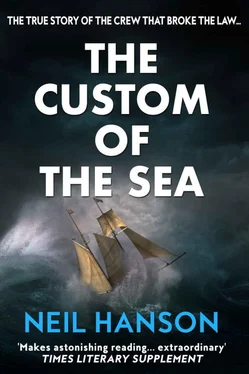The crew swarmed over the rigging, tarring the ropes, shrouds and stays. The mast and yardarms were scraped and painted, the decks holystoned and even the cable and anchor were banged with hammers to remove the rust.
As they neared the approaches to the Channel, the ship was stopped to take soundings at every change of the watch. The sails were taken down and as the barque lost headway a man on the bowsprit swung the lead. Three others at intervals back along the deck held coils of the line, which they released in turn until bottom was found.
‘Seventy fathoms. Shell and sand.’
‘Make sail.’
Later that day, Friday, 5 September 1884, they were hailed by a pilot boat. Gustavus Lowry, Falmouth pilot first-class, was cruising the western approaches to the Channel in Pilot Boat 13, looking for trade. It was a cut-throat business and pilots often tried to steal a march on their rivals by meeting vessels making for the Channel as far to the west as possible.
Lowry had one of the fastest pilot cutters in the area. It gave him an advantage over his rivals, for he would often find himself racing as many as three other pilots towards a sail sighted on the horizon, but he had had no luck that day. Every ship he had hailed was bound for a port further up the coast.
He was beginning to resign himself to a fruitless day when he hailed a triple-masted German sailing barque heading up Channel. ‘ Moctezuma , where are you bound?’
Captain Simonsen came to the rail and called down to him. ‘We’re bound for Hamburg, but we’ve three English castaways to discharge.’
‘Then you’ll be needing a pilot. I’ll take you in to Falmouth. Carrick Roads is the best harbour in England, a mile wide and almost as deep. You can enter in any sea conditions, whatever quarter a gale may blow from.’
Simonsen smiled. ‘Then why do we need a pilot?’
‘Because it’s the law. You can’t enter the Roads without one.’
‘Then come aboard.’
Once the Moctezuma was again under way, Simonsen invited Lowry to his cabin. ‘You’ll take a drink?’ He poured him a tot, then gestured to Tom. ‘This is one of our castaways. We rescued them thirty-eight days ago in the South Atlantic.’
Tom shook the pilot’s hand. ‘Tom Dudley, formerly captain of the yacht Mignonette , lost in a storm on a voyage to New South Wales.’
‘And how long were you adrift?’
‘Twenty-four days in an open boat.’
The pilot’s gaze took in Tom’s gaunt, ravaged face and the scarred, lath-thin forearms poking from his sleeves. ‘Your sufferings must have been terrible. How many were there of you?’
Tom’s gaze flickered to Captain Simonsen, then back to Lowry. ‘Four.’
‘And what became of the other one? Was he drowned?’
‘He was killed.’
‘When the ship was lost?’
‘No.’
Lowry studied him in silence for a moment. ‘And who killed him?’
‘I did.’
The pilot nodded, impassive. There was not a seafaring man afloat who had not heard such grisly tales, nor one who doubted that he would take the same measures in the same dire need.
‘It’s the custom of the sea,’ Lowry said. ‘You drew lots?’
There was the faintest hesitation before Tom’s reply. ‘No.’
For the first time the pilot’s face showed shock.
‘I wanted to,’ Tom said, ‘but the others would not agree. A few days earlier the boy drank sea-water. He was nearly dead. It would have been folly to have drawn lots then.’
Lowry gave a slow nod, though his expression remained thoughtful.
* * *
The Moctezuma was driven up the Channel by a stiff south-westerly breeze. More and more sails appeared on the horizon and soon boats were thick on the water — coasters and tramp steamers, fishing smacks heading in with the day’s catch, pleasurecraft and racing yachts hugging the shores, barques and frigates outward bound, beating against the wind.
In the early hours of the following morning they rounded Lizard Point and Lowry guided the ship north along the coast of the peninsula. As they passed the Manacles reef, Tom saw the light on St Anthony Head in the distance ahead of the ship, a sight he had never thought to see again. Beyond it lay Falmouth.
As the pre-dawn light began to strengthen, he saw the towers of tin mines rising from the clifftops above the jagged coastline and smoke drifting upwards from houses clustered around the sheltered coves. The steep cliffs of Nare Point and Rosemullion Head, flanking the Helford river, appeared on the port beam.
As the Moctezuma glided into Falmouth Bay, Tom glanced up at a familiar landmark, the arsenic works with its tall chimneystack high on an exposed clifftop above Pennance Point, where the prevailing westerlies blew the poisonous fumes away from the town.
Lowry set the ship’s course for the broad channel between the headlands, steering west of Black Rock, its marker-buoy jutting from the middle of the channel like the broken spire of some drowned church. The Moctezuma passed below the rusting, silent guns of the Tudor forts on Pendennis Point and St Mawes, and entered Carrick Roads.
* * *
As Lowry had boasted, it was the finest natural harbour in England and one of the largest in the world. Fed by seven rivers, it was deep enough for the largest ocean-going ship to find anchorage, but accidents of geography and climate had prevented it from becoming one of the great ports. There was no large agricultural or industrial hinterland to support it. The output of even the biggest tin mines was only a handful of tons a week, and was as likely to be shipped out by rail or through any of the multitude of small ports in every creek, river and inlet along the coast.
Its strategic position at the western approaches to the Channel should still have made it Britain’s premier naval base, but while the harbour was shielded from every other direction, it was impossible for a square-rigged sailing ship to leave Carrick Roads in the teeth of a southerly gale. To make ground into the wind, a sailing ship has to be able to present the leading edge of a sail to it. The difference in air pressure between the two sides of the sail generates lift, and it is this that drives the boat forward.
A yacht like the Mignonette , with a sail attached to a boom that swung over to change tack, could be sailed far closer to the wind than the clumsy square-riggers. Their rigid yards at right angles to the mast made it impossible for them to make any progress in anything approaching a head-wind.
The prevailing westerlies in the Channel would often pin the French fleet in harbour at Brest, but such gales often backed southerly. Britannia’s square-rigged ships-of-the-line could not rule the waves if the French were able to put to sea while the British fleet was trapped in harbour. As a result, Falmouth was passed over in favour of Plymouth.
The packet boats carrying mails brought some prosperity to the town but the trade was narrow in focus. To deter attacks by pirates, the fast, armed boats were forbidden to carry any other cargo than the mails. The only trade goods they carried were those hidden in the sea-chests of the crewmen, and the gemstones they smuggled attracted the largest Jewish population in England outside London and made Falmouth a temporary rival to Antwerp and Amsterdam.
Falmouth had held the mail contract since 1688, but it was lost to Southampton in 1852, and the port began to decline. There was still work for some yards repairing ships limping into port after a battering from gales on the Atlantic crossing. Ships loaded at other ports also continued to make a last call at Falmouth ‘for orders’ from the shipping agents who, gauging the current market conditions in a hundred overseas ports, would give them their destination. Falmouth’s central wharves remained busy and bustling, but the days of the packet boats were now long past and an air of dilapidation and dereliction hung over the outlying docks.
Читать дальше











